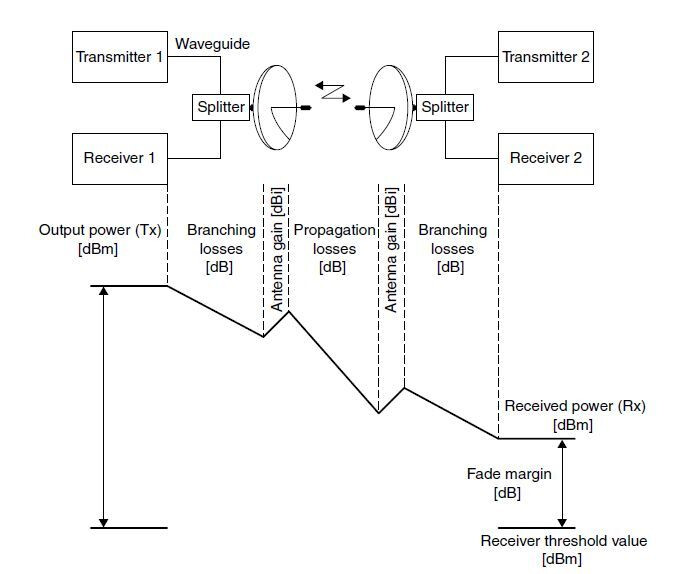It is the process of designing a microwave communication system such as data rate, distance, and reliability. One of the most important aspects is the calculation of propagation losses.
-
Propagation losses: The losses that occur as a microwave signal travels through space. They are caused by a variety of factors, including free space loss, gas attenuation, attenuation due to obstacles, and attenuation due to ground reflections.
-
Link budget: To determine the received signal level at the receiver end of a microwave link. It takes into account the transmitted power, the propagation losses, and the receiver sensitivity.
-
Fade margin: The extra margin of signal strength that is added to the link budget to account for unpredictable fading. Fading can be caused by a variety of factors, such as rain, multipath propagation, and atmospheric turbulence.
-
System gain: The total gain of the transmitter and receiver antennas in a microwave link. It is added to the link budget to improve the received signal level.
Link budget calculation
Received signal level = Transmitted power + System gain - Propagation losses - Fade margin
-
Free Space Loss (attenuation): The attenuation that occurs as a microwave signal travels through empty space. It is calculated using the following equation:
Free space loss = 92.45 + 20log(f fre in Ghz) + 20log(d link distance in KM) -
Gas attenuation: Due to absorption of microwave signals by the gases in the atmosphere, such as water vapor and oxygen. It is calculated using the following equation: = 0.024f1.6 (dB/km)
-
Attenuation due to obstacles:The diffraction of microwave signals around obstacles. It is calculated using a variety of methods, such as the knife-edge diffraction model.
-
Attenuation due to ground reflections: It is calculated using a variety of methods, such as the Fresnel reflection model.
-
Fading: It is a major consideration in microwave link design. It can be accounted for by adding a fade margin to the link budget. The fade margin is the extra margin of signal strength that is added to the link budget to account for unpredictable fading.
Fading types
-
Selective fading: When different frequency components of a microwave signal are attenuated differently. This can cause distortion of the received signal.
-
Flat fading: When all frequency components of a microwave signal are attenuated equally. This causes a reduction in the received signal level, but does not cause distortion.
-
Multipath fading: When a microwave signal arrives at the receiver via multiple paths. This can cause interference between the different paths, which can lead to fading.
-
Rain fading: When mw signals are attenuated by rain. The amount of rain fading depends on the frequency of the signal and the intensity of the rain.
-
Refraction-diffraction fading (k-type fading): It occurs when microwave signals are refracted and diffracted by the atmosphere. This type of fading is most common at low frequencies.
LinkedIn: ![]()
